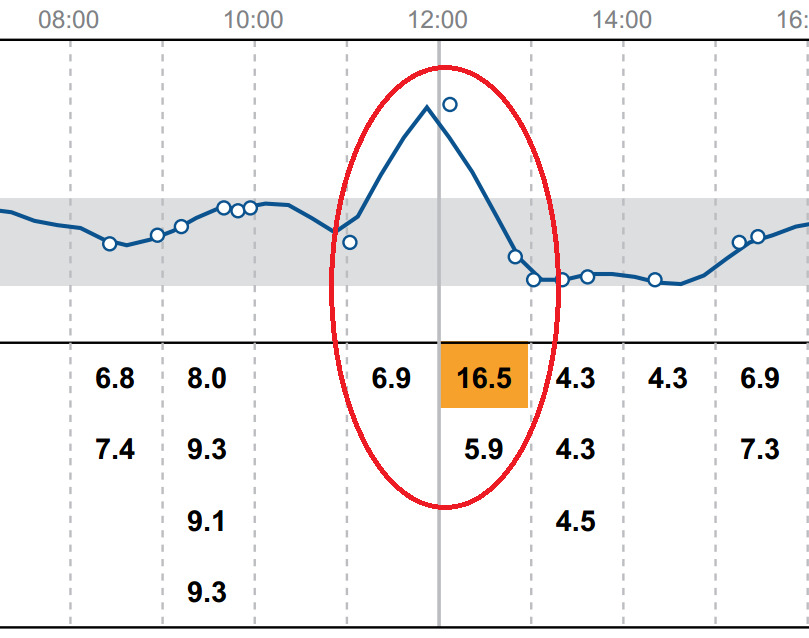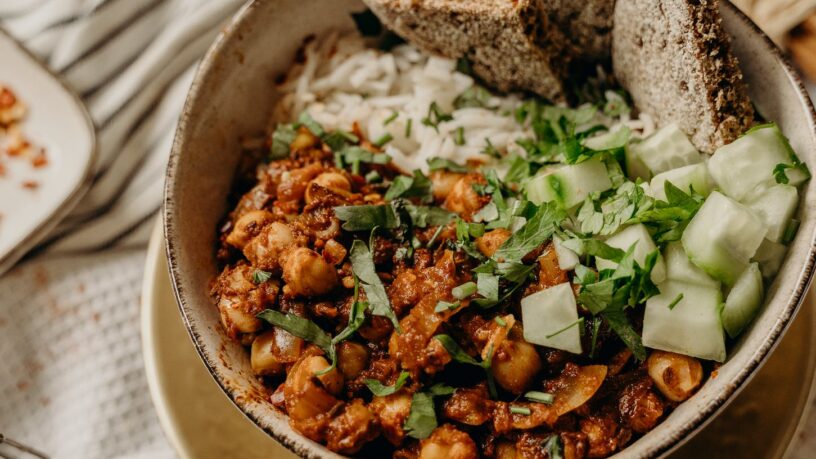This text reflects on the concept of using glycemic index (GI) and glycemic load (GL) as indicators in having a well-balanced and healthy diet. It reveals in which situation low or high GI is appropriate, as well as worthless, whilst having in mind both athlete and non-athlete lifestyle. It is necessary to understand that almost every food has its adequate place, time and purpose in our life and thus (its own) proper intention.
The concept of glycemic index is also used in the treatment of Diabetes. However, even in the most ideal circumstances we are unable to define blood glucose variations. Therefore, diabetics should continuously educate themselves and monitor their blood glucose while comprehending their own reaction and ability to cope with these challenges.
The Theory
Glycemic Index (GI) was developed to define the rise in blood glucose after consuming a particular amount of food i.e. carbohydrates included in them. It tries to theoretically demonstrate the rise of our blood glucose when consuming 20 g of carbohydrates in foods vs 20 g of pure glucose (dextrose); dextrose in this case being the reference value of 100. The key here is actually the phrase ‘to define’ because our blood glucose rise depends on various elements which can be altered on a daily basis (hormonal reactions for instance). The concept of GI definitely changed the opinion of many ‘experts’ in the nutrition field and this is a good thing. However, we cannot take it as an exclusive and one-dimensional number.
GL = GI x carbohydrates (g) / 100
Carbohydrates = Total Carbohydrates – Dietary Fiber

Glycemic load (GL) was developed due to the fact that, in addition to the glycemic index, the amount of the food itself also affects the rise in blood glucose. Unfortunately, this is true… but also logical: consuming 100 g of bread theoretically raises glucose twice as much as 50 g of bread. As a consequence, consuming 100 g also requires (theoretically) twice as much insulin to stabilize glucose.
The Practice
The formulation of GI actually serves as an indicator and an instrument, and by no means as a one-way street. Keep in mind that numbers can sound very accurate… Food Y raises glucose by 5 and Food X by (let’s say) 17. These numbers should not be taken for granted by any means, but perceived as a rough estimate of what can potentially happen to our blood glucose. The reality is much more complex because this increase in blood glucose is also influenced by various individual circumstances (other foods we consume – protein / fat / fiber; our hormonal response to the type of food; activities we are in, etc.).
What is the purpose of knowing GI or GL?
The purpose is to improve the quality of life and thus our personal health and wellbeing. If we (at least) roughly understand the concept of glycemic index and load, we’ll be able to logically assume the proper timing of certain foods. Let’s be brutally clear => the food we eat is the cure not only for our health problems in general, but it is often neglected in sports industry as that edge element in achieving maximum sports results. Therefore, we should use these information as a tool in our daily lifestyle. As an active athlete, we should clearly see the positive effect of (both) low or high GI and GL values, whilst (of course) having in mind the type of training and the recovery period. In addition, we can somewhat easily determine the most beneficial combination of foods, regardless of the situation we find ourselves in.
How familiar we actually are with these concepts?
I would say minimally…if at all. The GI of foods can serve as a guidance if our goal is to eat smarter. Personally, I try to educate my clients to think logically as possible and to be realistic. For instance, what is the purpose – for someone who is not physically active and never try to empty their glycogen stores – to consume a high GI index before bed? Really, what is the actual benefit of this???? I personally don’t see it… However, we most often do this on a daily basis. After decades of ‘nurturing’ this habit, we are in disbelief: why I cannot lose weight, why do I have trouble sleeping, why am I tired in the morning, why do I have a low spike in energy during the afternoon…Well, metaphorically speaking:
- You are not using your glycogen stores effectively
- You consume the wrong foods at the wrong time
- You are not competent in the field of nutrition
GI and GL as a tool in Sports
Never be afraid of new information. By being familiar with the concept of GI and GL athletes, personal trainers and teams can this tool to achieve maximum results. Maximum result is actually a combination of smart training process, talent and various circumstances that may surround a certain individual. If we understand the concepts of glycemic index and load, we will be able to use them regularly as an advantage; we will have the choice to maintain a healthier lifestyle and feed our muscles in accordance with their needs, as opposed to the regular ‘whatever’ attitude towards nutrition.
When to choose high or low GI
Foods with high GI values are beneficial if dealing with low blood glucose levels or generally throughout your sports activities (immediately before, during and immediately after).

Extremely low blood glucose may be a reflection of prolonged fasting combined with exhausting physical activity. Each person may experience different symptoms, but final outcome is usually the same, resulting in a mere inability to perform any activity whatsoever. Some of the most common low blood glucose symptoms are:
- dizziness
- a feeling of deep hunger
- headache
- confusion
- inability to concentrate
- sweating
- shivering
- blurred vision
- mood swings
Low blood glucose levels can substantially be increased with even small amounts of high GI foods. We can definitely learn about this from Diabetes, as those patients actually escape from low blood glucose crisis in this way. If we don’t feel good and are aware of this issue, even two small teaspoons of honey (roughly about 15 grams) will raise blood glucose levels very quickly. Before that happens, neuromuscular effect (through smell and initial taste) will cause the secretion of sebaceous glands, actually announcing the arrival of carbohydrates. In this way the brain itself will neurologically alleviate the ‘panic’ in advance.
On the other hand, metabolically, what is the purpose of consuming high GI foods regularly? I mean, really??? A high GI demands an aggressive insulin response which also aggressively tries to counterbalance glucose rise. Consequently, our body constantly suffers from large glucose/insulin spikes and unstable variations (illustration graph below) which culminate in energy imbalance. In addition, by not being physically active, our glycogen stores are regularly full; excess carbohydrates cannot be properly stored so they are being converted to fat. .

The world of Sports Nutrition is well known for using high GI values. The logic is simple => do not waste time on absorbing and converting carbohydrate content into glucose. Often, there is still a mistake that happens regularly, especially in long-distance events => athletes consume a certain food / product for the first time during a race or event, which very often results in rejecting the content and sending it back where it came from. Therefore, training sessions should be used to practise nutrition intake as well, regardless of the type (solid, liquid) of foods involved. In this way we are actually training our gut and preparing our muscles to accept nutrient intake during stressful situations (which training certainly is). Let’s be smart about this and train our gut regularly. In this way we can formulate the best possible (i.e. palatable) option for our metabolism. We should use our training sessions to simulate the effort of the race itself and, if our event requires, use it to check our reaction to various nutrient intake.

When to choose foods with a low GI?
Briefly – the more often, the better. Why? Because foods with low GI values cause a milder increase in blood glucose and thus cause less of the above mentioned instabilities. For instance, it is very clear that, vegetables are almost completely characterized by low numbers in this regard. By consuming seasonal type of vegetables, we contribute not only to the healthy lifestyle, but we also consume a wide range of vitamins and minerals, which act as some sort of domino effect, strengthening our immune system and overall health. This happens regardless of our body type, activity level or training in general. Things are pretty clear here…
Good to know
The concept of GI and GL are not established for such foods for independent consumption. Keep in mind that GI defines those foods that contain carbohydrates; a complete i.e. nutritionally rich meal involves other components as well. The breakdown of proteins and fats will certainly alleviate the sudden rise in blood glucose. However, bear in mind that blood glucose rise will certainly happen, but the metabolism will not have the freedom to deal exclusively with dissolving the carbohydrate content.
Also, data for GI and GL are based on certain food varieties, which are not defined in every single country. We can often find that, for instance, the above-mentioned honey is extremely high in some sources (62), and somewhat lower in others. It is, however, important at least subconsciously to have some sort of clue about the certain food or ingredient. In this way GI and GL data will certainly guide us in the right direction when preparing or consuming a meal.

The world of Diabetes Mellitus
When it comes to GI, diabetics are a very interesting group. Even a low glycemic index of a very healthy food can significantly increase blood glucose and affect mood and regulation throughout the day. Why? Because the food contains carbohydrates; if it is consumed in larger quantities, more carbohydrates are ingested which will sooner or later (try to) increase blood glucose …….’try ‘? We have insulin…
Diabetic will know his/her reaction to a certain carbohydrate food and try to adjust the amount of insulin, depending on the amount consumed and his/her planned activities. However, with diabetes, situation is regularly unpredictable and mystical because blood glucose is affected not only by carbohydrates from foods they eat, but also by a whole range of metabolic (hormonal and enzymatic) reactions that are everything but identical on a daily basis. Thus, the theoretical calculations of an insulin bolus in relation to the amount of carbohydrates consumed will remain a mystery, and by no means a solvable equation. A diabetic, therefore, has a task to study his/her own metabolic reactions and, through various situations and self-education, constantly analyze his/her own reactions to certain foods. In doing so, the most important thing is to consume food as needed, by giving his body what it needs when it needs it; but also, in amount that it needs it.

Summary
GI and GL definitely have their purpose in our life as they educate about characteristics of foods and products. By knowing such properties and characteristics, we work on our own perception of food as a medicine because we understand the concept and proper timing of food in our diet. Consumption of foods with low GI and GL does not mean our insulin reaction will be limited or completely reduced, but only somewhat slower. Yet, having a tool like this and not using it when trying to create a nutritionally rich meal definitely gives us low credibility in maintaining physical and mental health in general.

